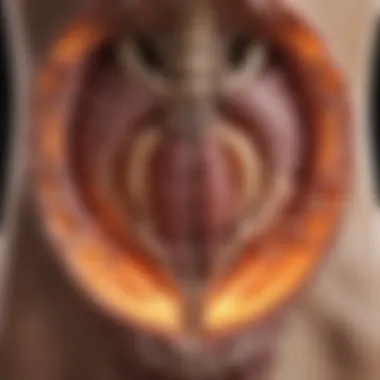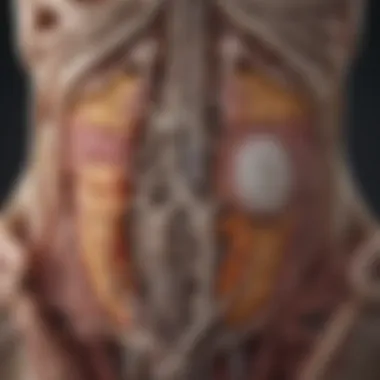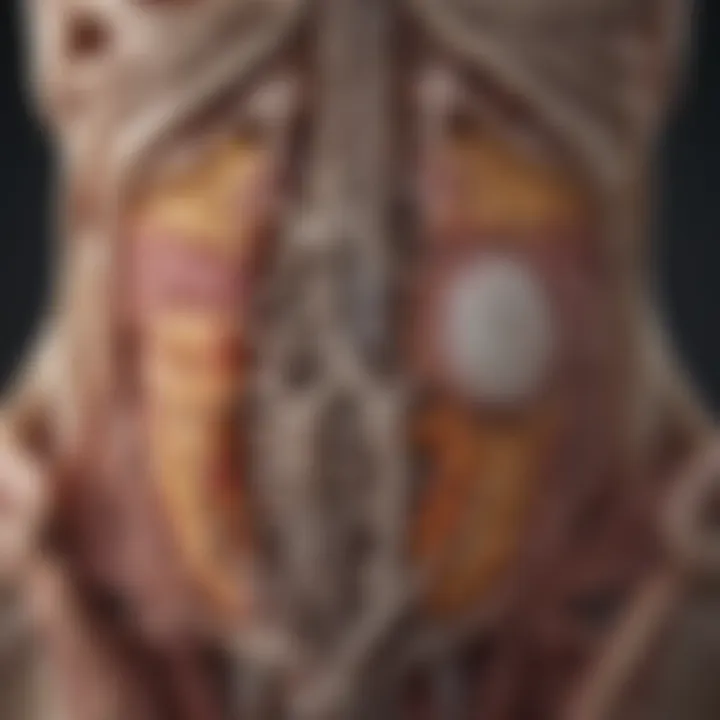Understanding Ankylosing Spondylitis in the Sacral Region


Intro
Ankylosing spondylitis (AS) is a chronic inflammatory disease, affecting many individuals worldwide. It manifests primarily in the axial skeleton, with the sacral region being particularly vulnerable. Understanding AS is crucial because it impacts daily life through pain and decreased mobility. While pain relief is a common goal, the larger context includes managing the entire impact of the disorder.
The sacral region consists of five fused vertebrae at the base of the spine. This area serves critical functions for mobility and stability. When inflammation occurs in this region, it can lead to debilitating symptoms. Both early diagnosis and ongoing management can make a significant difference in patient outcomes.
This article aims to provide a detailed examination of ankylosing spondylitis in relation to the sacral region. We will explore its etiology, the underlying pathophysiology, and clinical manifestations. Furthermore, we will analyze diagnostic protocols and management strategies, emphasizing modern treatment options that enhance quality of life. Recent research will also be discussed, shining a light on the future of AS therapy.
By diving into these topics, our objective is to offer readers a comprehensive understanding of ankylosing spondylitis and its relevance to the layperson, professionals, and researchers alike.
Research Overview
Summary of Key Findings
This section will summarize significant studies and discoveries relevant to ankylosing spondylitis. Recent findings reinforce the inflammatory nature of AS, with genetic links traced to the HLA-B27 antigen. Research shows a strong correlation between HLA-B27 positivity and the likelihood of developing AS. Other studies have focused on the role of lifestyle factors, including physical activity and diet, in disease management.
"Understanding the genetic markers of ankylosing spondylitis can lead to better targeted therapies."
Relevance to Current Scientific Discussions
The current discussion in the medical community centers on inflammation and its systemic effects. New treatment modalities, including biologics such as etanercept and adalimumab, have shown promise in managing AS. These discussions extend beyond immediate symptoms to consider long-term quality of life improvements.
Methodology
Research Design and Approach
The methodology adopted in studies related to AS frequently involves a mixed-methods approach. This combines quantitative analysis with qualitative assessments of patient experiences. Clinical trials are crucial for understanding the effectiveness of new treatments and improving existing protocols.
Data Collection and Analysis Techniques
Data collection often relies on patient surveys, imaging studies like MRI, and genetic testing. Recent advancements in artificial intelligence are also utilized in analyzing large datasets to identify patterns in disease progression.
In summary, ankylosing spondylitis remains a complex disorder, and ongoing research continues to evolve our understanding of its numerous facets. This article will explore each aspect in detail, thereby enriching the knowledge base for all stakeholders involved in AS research and management.
Preface to Ankylosing Spondylitis
Ankylosing Spondylitis is a significant topic because it presents profound implications for numerous individuals. The condition mainly impacts the axial skeleton, with the sacral region being a critical area of concern. Understanding this condition is essential not only for medical practitioners but also for those affected and their families. Knowledge of the disease can lead to better management strategies and improve the quality of life for many patients.
Definition of Ankylosing Spondylitis
Ankylosing spondylitis refers to a form of inflammatory arthritis that primarily affects the spine and the sacroiliac joints. It frequently results in chronic pain and stiffness, particularly in the lower back and pelvis. In severe cases, the inflammation can lead to a fusion of the vertebrae, resulting in a rigid spine. This condition is classified under a broader category known as axial spondyloarthritis.
The exact cause is not entirely understood but it is believed to involve genetic predispositions, as well as environmental factors. Those suffering from this condition often experience periods of exacerbation and remission, which can complicate diagnosis and management.
Prevalence and Demographics
The prevalence of ankylosing spondylitis varies among different populations. Research indicates that it affects approximately 0.1% to 1.4% of the general population. The condition is more common in males than females, with a ratio of around three to one. It typically manifests in early adulthood, usually before the age of 45. Individuals with a family history of autoimmune diseases or spondyloarthritis are at a greater risk.
Furthermore, the HLA-B27 antigen is strongly associated with ankylosing spondylitis. A significant percentage of people with the disease test positive for this antigen, although not everyone with the HLA-B27 marker will develop the condition.
It is essential for healthcare providers to recognize the patterns of this disease within diverse demographics, enabling better-targeted prevention and treatment strategies.
Anatomy of the Sacral Region
Understanding the anatomy of the sacral region is crucial for comprehending the impact of ankylosing spondylitis (AS) on this area. The sacrum is a triangular bone at the base of the spine, connecting the lumbar vertebrae to the coccyx. It forms the posterior part of the pelvis and plays an essential role in weight-bearing and stability. In individuals with AS, changes in this region can lead to significant functional impairments.
Skeletal Structure
The skeletal structure of the sacral region is made up of five fused vertebrae, denoted as S1 to S5. These vertebrae are integral to the spinal column, providing support and facilitating movement. The sacrum connects with the ilium of the pelvis at the sacroiliac joint, allowing for mobility during walking and other activities. In patients with ankylosing spondylitis, inflammation can cause these joints to become rigid, leading to decreased flexibility and increased pain.
Characteristics of the Skeletal Structure of the Sacral Region:
- Fused Vertebrae: The fusion of sacral vertebrae creates a solid structure that helps bear weight, but in AS, fusion can occur earlier than in healthy individuals.
- Attachment Points: The sacrum serves as an attachment point for various ligaments and muscles, which are important for posture and movement.
- Sacroiliac Joint: This area is often the first to demonstrate symptoms in AS, leading to significant discomfort.
Overall, the skeletal anatomy of the sacral region is foundational to understanding the mechanics affected by ankylosing spondylitis.
Nervous System Connections


The nervous system connections within the sacral region facilitate communication between the brain and the lower body. Nerves emerging from the sacral plexus innervate muscles and skin in the lower limbs. Disruption in these pathways can affect motor and sensory functions, often leading to complications in AS.
Key Points on Nervous System Connections:
- Sacral Plexus: A network of nerves that originate from spinal nerves L4 through S4. It is crucial for lower extremity function.
- Motor Function Impact: In severe cases of AS, nerve compression or damage can lead to weakness in the legs and reduced mobility.
- Sensory Connections: Patients might experience altered sensations in the legs as inflammation affects the nerves.
Understanding the nervous system connections in the sacral region helps illuminate how ankylosing spondylitis can lead to complications beyond physical symptoms, impacting overall quality of life.
"The integration of skeletal and nervous structures in the sacral region profoundly influences the functional capabilities of individuals with ankylosing spondylitis."
Etiology of Ankylosing Spondylitis
The etiology of ankylosing spondylitis (AS) is vital to understand, as it encompasses the underlying causes and contributing factors of the disease. This section allows us to delve into the roots of AS, providing insight into how genetic and environmental influences interplay to trigger its onset. Understanding these elements is critical, not only for diagnosis but also for developing more effective management strategies. The implications of this knowledge help in enhancing treatment responsiveness and addressing patient-specific needs.
Genetic Factors
Genetic predisposition plays a significant role in ankylosing spondylitis. Research has consistently identified the HLA-B27 gene as a primary genetic marker associated with the condition. Approximately 90% of individuals diagnosed with AS possess this allele, indicating a strong correlation between genetics and the likelihood of developing the disease.
- HLA-B27 Association: The presence of the HLA-B27 antigen facilitates abnormal immune responses, potentially leading to inflammation in the sacral region.
- Family History: A family history of ankylosing spondylitis further increases an individual’s risk, suggesting that multiple genes may contribute to disease susceptibility.
- Other Genetic Factors: Research continues to unveil other genetic elements associated with AS, including IL-23 receptor genes, which may influence the disease’s progression and severity.
Understanding these genetic factors is crucial for early diagnosis and targeted treatment approaches. Genetic testing may aid in identifying at-risk individuals and guiding preventive measures.
Environmental Influences
While genetic factors are significant, environmental influences also play an essential role in the development of ankylosing spondylitis. These can interact with genetic predispositions, complicating the pathophysiology of the disease. Some key environmental factors include:
- Infections: Certain bacterial infections, particularly those linked to the gut microbiome, have been implicated in triggering AS in genetically predisposed individuals.
- Mechanical Stress: Repeated mechanical stress on the spine and pelvis may contribute to the exacerbation of inflammatory processes in those at risk.
- Lifestyle Factors: Smoking and an inactive lifestyle have been associated with a delayed onset of symptoms or increased severity of ankylosing spondylitis.
"The interplay between genetics and environment is complex and necessitates a multi-faceted understanding of ankylosing spondylitis."
Recognizing these environmental influences is essential for not only understanding the etiology of AS but also for developing tailored interventions that could potentially mitigate risk factors. By accommodating these aspects within treatment frameworks, healthcare professionals can enhance the overall management of this chronic condition.
Pathophysiology of AS in the Sacral Region
Understanding the pathophysiology of ankylosing spondylitis (AS) in the sacral region is crucial. This section delves into the underlying processes that contribute to the condition's progression. It highlights how these mechanisms directly relate to symptoms experienced by individuals and informs effective management strategies. By examining the inflammatory processes and the role of bone remodeling, we gain insights into the chronic nature of this disease.
Inflammatory Processes
The inflammatory processes in ankylosing spondylitis begin with an abnormal immune response. The sacroiliac joints, where the spine connects to the pelvis, often become inflamed. In individuals with AS, there is an increased presence of proinflammatory cytokines such as tumor necrosis factor-alpha (TNF-α) and interleukin-6 (IL-6). These cytokines play a significant role in mediating inflammation and exacerbating pain.
Inflammation leads to swelling and increased blood flow to affected areas, which can worsen discomfort and stiffness for the patients. The chronic nature of this inflammation creates a cycle where tissue damage fosters ongoing immune activity. This is compounded by systemic effects affecting other joints and potentially the entire axial skeleton.
Furthermore, it is pertinent to note the HLA-B27 antigen's association with AS. Around 90% of individuals with ankylosing spondylitis carry this antigen, suggesting a genetic predisposition to inflammatory responses.
Bone Remodeling and Fusion
Another critical aspect of AS is the process of bone remodeling and fusion. Over time, persistent inflammation in the sacroiliac joints can lead to changes in bone architecture. This process involves multiple cell types, including osteoblasts and osteoclasts. Osteoblasts are responsible for new bone formation, while osteoclasts are involved in the resorption of bone.
In AS patients, there is excessive activity among these cells, leading to abnormal bone formation. The continuous inflammatory cycle prompts new bone to form where it is not typically found, resulting in a characteristic fusion of vertebrae known as syndesmphyte formation. This ultimately leads to a reduced range of motion and significant stiffness.
The fusion can contribute to a stooped posture as the spine becomes less flexible. Moreover, the sacral and lumbar regions are primarily affected, highlighting the disease's impact on overall mobility.
"The pathophysiological processes underpinning ankylosing spondylitis are complex, yet they are fundamental to understanding the disease's burden on individuals and the healthcare system."
In summary, comprehending the pathophysiology of AS in the sacral region provides crucial insights into its inflammatory mechanisms and structural changes in bones. This understanding lays the foundation for targeted therapeutic strategies and informs patient care.
Clinical Manifestations
Understanding the clinical manifestations of Ankylosing Spondylitis (AS) is essential for both diagnosis and management of the disease. The symptoms often provide the first clues regarding the condition, influencing how the disease is perceived and treated. Recognizing these manifestations is vital for timely intervention, which can substantially impact the patient’s quality of life.
Typical Symptoms
Typically, symptoms of AS begin gradually and can be misinterpreted as signs of common back pain. Key symptoms include:
- Chronic Lower Back Pain: Pain in the lower back is often the most prominent complaint. It is typically worse during rest, especially at night, and may improve with physical activity.
- Stiffness: A notable stiffness, particularly in the morning, affects the sacral region and can limit mobility.
- Postural Changes: Patients may develop a stooped posture due to rigidity in the spine. Over time, this can lead to significant changes in physical appearance.
- Fatigue: Chronic inflammation can cause a sense of fatigue, contributing to the overall burden of the disease.
Patients often describe an ebb and flow of symptoms, with periods of increased symptomatology followed by relative respite. It is also crucial to understand that the severity and manifestation can vary greatly among individuals.


Complications Specific to the Sacral Region
The sacral region is particularly vulnerable in ankylosing spondylitis, leading to complications that can exacerbate the overall impact of the disease. Key complications include:
- Sacroiliitis: Inflammation of the sacroiliac joints often leads to pain and reduced function, which can significantly hinder everyday activities.
- Reduced spinal flexibility: Fusion of joint structures can reduce mobility. This may affect daily tasks and hinder physical activity, impacting physical fitness.
- Neurological Issues: Although less common, severe inflammation in the sacral region may lead to neurological complications. Nerve root involvement may cause sensations of tingling or numbness in the legs.
- Psychosocial Impact: The chronic pain and physical limitations can lead to depression and anxiety, making psychosocial support a critical component of disease management.
Understanding these symptoms and complications not only assists in improving the diagnosis of AS but also enhances the approach to treatment, emphasizing the need for a multidisciplinary management strategy.
Diagnosis of Ankylosing Spondylitis
Diagnosing ankylosing spondylitis is critical for providing timely treatment and managing the progression of the disease. Understanding the various diagnostic approaches is important for both healthcare professionals and patients. Early detection can lead to treatment that may slow disease progression and improve quality of life. Effective diagnosis relies on a multifaceted approach that includes clinical assessments, imaging techniques, and laboratory tests.
Clinical Assessment
A comprehensive clinical assessment is the first step in diagnosing ankylosing spondylitis. This involves a detailed medical history, where the healthcare provider examines symptoms such as:
- Chronic back pain: Often worsening over time.
- Stiffness: Particularly in the morning or after periods of inactivity.
- Limited spinal mobility: Affected individuals might show reduced flexibility or difficulty in certain movements.
- Family history: Genetic predispositions, especially among first-degree relatives, can be significant.
In addition to symptom evaluation, physical examination is crucial. The doctor may perform tests to assess:
- Posture: Any visible abnormalities.
- Spinal mobility: Range of motion in flexion, extension, and lateral movements.
- Tenderness: Checking for discomfort in specific areas such as the sacrum.
This clinical assessment not only guides further diagnostic efforts but also helps establish a baseline for monitoring progression over time.
Imaging Techniques
Imaging plays a significant role in diagnosing ankylosing spondylitis, especially when clinical assessments raise suspicion. The major imaging modalities include:
- X-rays: Often the first imaging test used. They can reveal characteristic changes in the sacroiliac joints, which are typically affected in AS.
- MRI (Magnetic Resonance Imaging): More sensitive than X-rays for early detection of inflammation in the sacroiliac joints and spinal area. MRI can show active inflammatory changes before structural damage occurs.
- CT Scans: Can provide detailed images of bone structures, useful in assessing the severity of changes in the spinal column or pelvis, although less commonly used than MRI.
These imaging techniques aid in confirming a diagnosis and assessing the severity of joint or spinal involvement, which is essential for planning appropriate treatment.
Laboratory Tests
Laboratory tests are supplementary tools in diagnosing ankylosing spondylitis. While no single test can definitively diagnose AS, several tests can help:
- HLA-B27 Test: This genetic marker is present in a significant percentage of individuals with ankylosing spondylitis. However, not everyone with the marker will develop the condition, so this test is not conclusive.
- Inflammatory Markers: Elevated levels of C-reactive protein (CRP) and erythrocyte sedimentation rate (ESR) indicate inflammatory activity. These tests cannot specifically diagnose AS but provide additional information about the inflammatory state of the body.
- Blood Tests: Routine blood work may also be conducted to rule out other conditions that could mimic symptoms of ankylosing spondylitis.
Integrating laboratory results with clinical assessment and imaging findings allows clinicians to develop a clearer picture of the patient's condition, facilitating better-informed management decisions.
An early and accurate diagnosis of ankylosing spondylitis can significantly enhance patient outcomes by guiding timely intervention and therapy.
Through these multifaceted assessments, diagnosis can be efficiently achieved, laying the groundwork for effective management and support strategies for those living with ankylosing spondylitis.
Management Strategies
Management strategies for ankylosing spondylitis (AS) are fundamental in mitigating the symptoms and improving the quality of life for individuals affected by the disease. AS is a complex condition that necessitates a multifaceted approach to address the varying needs of patients. This section will discuss the pharmacological approaches, physical therapy and exercise regimens, as well as potential surgical interventions. Each of these strategies plays a crucial role in managing the symptoms of AS, and understanding them helps to create a personalized treatment plan for affected individuals.
Pharmacological Approaches
Pharmacological treatments center around controlling inflammation and managing pain. Nonsteroidal anti-inflammatory drugs (NSAIDs) are often the first line of defense. Medications such as ibuprofen or naproxen effectively reduce pain and stiffness, thus improving function.
In more severe cases, disease-modifying antirheumatic drugs (DMARDs) like sulfasalazine may be prescribed to slow disease progression.
Biologics such as tumor necrosis factor (TNF) inhibitors and interleukin-17 (IL-17) inhibitors have emerged as groundbreaking treatments. These biologics specifically target the inflammatory processes that occur in AS, yielding significant improvements in symptoms.
"Biologics have revolutionized the management of ankylosing spondylitis, offering hope for many patients who do not respond to conventional therapies."
However, the decision to use specific medications involves considerations such as side effects, patient preferences, and comorbidities. Regular follow-ups to assess effectiveness and monitor for any adverse effects are also necessary.
Physical Therapy and Exercise
Physical therapy and exercise are critical components of AS management. They can help maintain mobility and reduce stiffness in the sacral region and other areas affected by the disease.
A tailored exercise program often includes:
- Stretching exercises: These enhance flexibility and help prevent joint stiffness.
- Strengthening exercises: Building core and back muscle strength supports posture and spinal alignment.
- Aerobic exercises: Activities such as swimming or cycling contribute to overall endurance and cardiovascular health.


Incorporating regular physical activity into daily routines empowers patients. It not only alleviates pain through improved blood circulation but also fosters mental well-being by combating fatigue and depression often associated with chronic illness. Physical therapy sessions led by well-trained physiotherapists can guide patients, ensuring exercises are performed correctly and safely.
Surgical Interventions
In certain situations, surgical intervention may become necessary. While surgery is not a standard treatment for AS, it is considered in cases of severe structural damage or significant functional limitations. Common surgical procedures include:
- Spinal surgery: This may involve corrective surgery for severe deformities or fusion of unstable joints to alleviate pain.
- Joint replacement: Hip or knee replacement may be performed on patients who experience significant joint damage impacting mobility.
Before pursuing surgery, it is crucial that patients explore all non-surgical options. Surgery carries risks and may not completely alleviate symptoms. An exhaustive discussion with a healthcare provider about the anticipated benefits, risks, and realistic outcomes is essential in the decision-making process.
Impact on Quality of Life
The impact of ankylosing spondylitis (AS) on quality of life cannot be overstated. It affects not only physical health but also emotional well-being and social interactions. Understanding these impacts is vital for both patients and healthcare providers as it can influence treatment choices and outcomes. When discussing quality of life, it is essential to consider both physical limitations and psychosocial factors. These aspects are intertwined, often exacerbating each other, which can lead to a significant decline in overall well-being.
Physical Limitations
Physical limitations arising from ankylosing spondylitis can significantly hinder daily activities. Patients often experience severe pain and stiffness in the sacral region, especially upon waking or after prolonged periods of inactivity. Basic tasks such as bending, lifting, or even walking may become challenging, leading to increased dependency on others.
Patients may experience the following physical limitations:
- Reduced Mobility: Stiffness in the spine can limit movement, making simple tasks difficult.
- Fatigue: Chronic pain can lead to tiredness, affecting exercise tolerance and daily function.
- Work Limitations: Many individuals must adjust work duties to accommodate their condition, which can affect career progress.
"Physical limitations are not just about pain. They can change how a person lives their life daily."
These limitations can lead to frustration and disappointment, underscoring the need for effective management strategies. Personalized exercise plans under professional guidance can help improve mobility and reduce stiffness, promoting a better quality of life overall.
Psychosocial Factors
The psychosocial impact of ankylosing spondylitis is profound and can complicate the physical aspects of the disease. As patients navigate the challenges of living with chronic pain, they may also face emotional and social hurdles. Factors include:
- Mental Health Issues: Anxiety and depression are common among individuals with AS. The chronic nature of the disease can create a feeling of hopelessness.
- Social Isolation: Patients may withdraw from social activities due to discomfort or fear of not being understood.
- Familial Strain: The impact of AS can extend to families, as loved ones may struggle to understand the limitations and fluctuations in health that their relatives experience.
Addressing these psychosocial factors is crucial. Support groups and counseling can provide a valuable outlet for sharing experiences and coping strategies. Integrating mental health support into treatment plans can also enhance adherence to physical treatments, promoting a more cohesive approach to managing AS.
Understanding both physical limitations and psychosocial factors is key to managing ankylosing spondylitis effectively. By recognizing how AS affects various aspects of life, patients and providers can work together to create strategies that enhance overall quality of life.
Research Developments
Research in ankylosing spondylitis (AS) has grown significantly, especially concerning its impact on the sacral region. Understanding this subject is vital to improve patient outcomes. Researchers continue to explore various aspects of AS, providing deeper insights into its etiology, pathophysiology, and management. This evolving knowledge base helps optimize treatment strategies and addresses the complexities of this condition.
Ongoing research leads to improved diagnosis processes and tailored management plans. Investigating genetic and environmental factors enhances understanding of individual susceptibility to AS. Moreover, advancements in imaging techniques allow for early detection of the disease, which is crucial for effective intervention. Current studies focus on understanding biomarkers that might predict disease progression and response to treatment.
The relevance of these developments is profound, encompassing the potential for more personalized medicine approaches in AS treatment. As researchers establish clearer connections between genetic predispositions and environmental triggers, more effective preventive and therapeutic strategies could be designed.
Current Research Topics
Several key research topics characterize the current landscape of AS studies. These topics include:
- Biomarkers for Disease Progression: Identification of specific biomarkers can help predict how the disease will progress in different individuals. This is essential for developing targeted therapies.
- Novel Therapeutics: Researching new medications that target inflammatory pathways provides potential for more effective treatment options. This can also lessen side effects associated with traditional therapies.
- Impact of Lifestyle Modifications: Examining how factors such as diet, exercise, and smoking affect the severity of AS helps in creating holistic management plans.
- Psychosocial Impacts: Studies are increasingly looking at how AS affects mental health and social well-being, indicating that comprehensive care models must consider both physical and psychological aspects.
These research avenues not only advance scientific knowledge but also have direct implications for clinical practice and patient care.
Future Directions in Research
Future research on ankylosing spondylitis aims to explore innovative therapy options and enhanced understanding of the disease's mechanisms. Key areas include:
- Genetic Studies: Investigating the genetic basis of AS can uncover new therapeutic targets and risk factors. Genetic analysis can aid in understanding why certain individuals develop severe symptoms while others have a milder course.
- Immunological Research: As AS is an autoimmune condition, delving into the immune response can lead to novel treatments. Understanding how the immune system interacts with the affected tissues will shape future therapeutic interventions.
- Longitudinal Studies: Following patients over extended periods can provide insights into the natural history of AS. This information is critical in identifying effective early interventions.
- Integrative Approaches: Combining traditional pharmaceuticals with alternative therapies, such as acupuncture and yoga, may enhance patient quality of life and treatment adherence.
Research in ankylosing spondylitis continues to evolve at a rapid pace. The combination of innovative treatments and a broader understanding of the disease offers hope for enhanced patient care and quality of life. Continued investment in research is essential to unlock further clues about this complex condition.
Epilogue
Summary of Key Points
- Definition and Prevalence: Ankylosing spondylitis primarily affects the axial skeleton, with a notable impact on the sacral area, leading to chronic pain and stiffness. Its prevalence varies across populations, indicating a need for personalized approaches to treatment.
- Etiology: The disease has complex origins, involving genetic predispositions and environmental factors. Recent studies highlight the role of specific genes, such as HLA-B27, in the disease development.
- Pathophysiology: The inflammatory processes lead to significant alterations in bone structure. This remodeling can result in fusion of the vertebrae, significantly impacting mobility and quality of life.
- Clinical Manifestations: Characteristic symptoms such as lower back pain and stiffness are common. Awareness of complications affecting the sacral region is essential for early diagnosis and management.
- Diagnosis: Proper diagnosis involves clinical assessment, imaging techniques like X-rays or MRIs, and laboratory tests to confirm the presence of inflammatory markers.
- Management Strategies: Treatment options have evolved, including pharmacological methods, physical therapy, and surgical interventions when necessary. These options aim to alleviate symptoms and improve life quality.
- Research Developments: Ongoing research is necessary to explore new therapeutic avenues and refine existing treatments. Understanding disease mechanisms can lead to innovative approaches in managing ankylosing spondylitis.
The Need for Continued Research
The ever-evolving field of ankylosing spondylitis research is crucial. As our understanding grows, so does the potential for more effective treatments. Continued research is essential for several reasons:
- Discovering New Treatments: Novel therapies might emerge that could provide better symptom relief or disease management strategies.
- Understanding Mechanisms: A deeper exploration into the inflammatory processes and genetic factors could shed light on precisely how AS develops and progresses.
- Personalization of Care: Increased knowledge can facilitate more customized treatment plans that cater to individual patient needs, enhancing overall effectiveness.
- Community Awareness: Research findings can help raise awareness in both medical communities and the public, leading to early diagnosis and better disease outcomes.
"The importance of continuous research in ankylosing spondylitis cannot be overstated, as it paves the way for hope in affected individuals and their families."
In summary, the attention and resources devoted to ankylosing spondylitis research are a testament to the commitment to improving the lives of those affected by this chronic condition. The future depends on our ability to fund and support ongoing research efforts.



